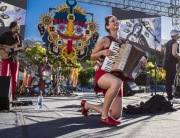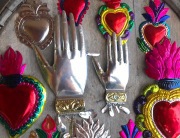International Folk Artists The Extraordinary Stories Behind The Extraordinary Art
“I wish I could put a basket made in Rwanda in the home of every American . . . by people who’ve been through things that no American will ever know. And they’ve concluded, after being humbled by their own rage and the pain of their losses, that what we have in common is much more important than our differences. If I could give one gift, I’d put that basket—with an explanation of what it is and who made it and why—in every home in America.” —PRESIDENT BILL CLINTON, Conde Nast Traveler, 2007
 The Artist: Janet Nkubana
The Artist: Janet Nkubana
The Region: Rwanda
The Medium: Hand-woven baskets
Total earnings from the Market (2008–2012): $166,607 Rwanda average daily income: $1.46*
*All figures according to 2011 United Nations Statistics Division, based on per capita GDP Janet Nkubana spent her childhood in a refugee camp in Uganda where she learned firsthand what it means to be poor and hungry. When she returned to her native Rwanda after the devastating genocide of 1994, she encountered scores of women, most of them new widows, facing the same challenges. She helped these women—Hutu and Tutsi—organize themselves into a basket-weaving cooperative Gahaya Links. “I realized that this was an opportunity not just for women to earn money, it was an opportunity to build peace,” says Nkubana. “It was a chance to help heal the wounds from the genocide and war. It did not matter if one woman’s husband had killed another’s. I said, ‘Don’t we breathe the same air? Speak the same language? Don’t we all love our children? Let us just weave and try to put the past behind us.’ “ In recognition of her work, Nkubana won The Hunger Project’s 2008 Africa Africa Prize for Leadership for the Sustainable End of Hunger. Today, Gahaya Links has close to 4,000 weavers whose art is helping them earn an income and rebuild lives. Artists from Gahaya Links have participated in the new artist training and Mentor to Market programs and were featured in the Empowering Women exhibit at Museum of International Folk Art in 2010. Nkubana returns to the Market with Gahaya Links’s signature “peace baskets.” These exquisite baskets are part of collections worldwide, including at MoMA. Coming out of the weaving traditions, Gahaya Links will also bring a new collection of earrings made by women with AIDS enabling them to make a sustainable living from their traditional craft.

The Artist: Aboubakar Sidiki Fofana
The Region: Mali
The Medium: Indigo Textiles Total earnings from the Market (2010–2012): $62,787
Mali average daily income: $1.64
In a story in Hand/Eye magazine, Karen Gibbs writes, “An experienced traveler and textile enthusiast recently said of Aboubakar Fofana, ‘One look in his eyes tells you he is an old soul.’ The same can be said of his methods.” A master artist, Fofana keeps alive the traditional practice of indigo dyeing that dates back to the 11th century in Mali. He has worked for years in Africa, France, Japan, and Great Britain to preserve the ancient dyeing techniques he uses for his sublime textiles. Elders first taught Fofana about indigo, igniting a passion for the techniques as well as for reviving the growth of biological indigo and organic cotton in West Africa. Fofana and his team of artisans spin and weave their cotton and linen by hand, then dye the fabric and sew each piece by hand. Photo © Bob Smith. All rights reserved.

The Artist: Rado Herivonona Ambinintsoa, Federation Sahalandy
The Region: Madagascar
The Medium: Hand-woven silk and cotton textiles
Total earnings from the Market (2011–2012): $70,581
Madagascar average daily income: $1.16
In the central highlands of Madagascar a girl’s life as an artisan begins at birth when she receives the tools with which she will someday learn to weave. A tradition that’s been passed from generation to generation for centuries, women still produce all of the silk and cotton, using natural dyes from native plants and weaving the fabric on eucalyptus looms. Now their artistry has become a way for them to make a living. Through a cooperative called Sahalandy, weavers learn how to sell their products to an international market. “It’s a lot about self-worth,” says Natalie Mundy, an American Peace Corps volunteer who lives in a small weaving community in Madagascar called Sandrandahy. “They know that if you do incredible work, there’s a market for it.” Sandrandahy used last year’s Market sales to help bring basic services of water and electricity to the village and enabled the cooperative to build trekkers huts encouraging eco tourism. 25-year-old Rado Herivonona Ambinintsoa (who had never left Madagascar when she represented the cooperative at the Market last year) returns with more stunning weavings and members of the cooperative were selected for the Market’s advanced training program, traveling to the Dallas Gift Market as part of the Santa Fe International Folk Art Market Collection where they showcased their valuable silk textiles and established relationships with buyers from around the country. This year the Market will premiere a new documentary film—The Silkies of Madagascar—as part of the Market’s 10th Anniversary celebrations. Tracing the dramatic story of the cooperative, the film shows how, with a little help, these skilled women traveled halfway around the world to Santa Fe to sell their valuable silk textiles at the Market, and in so doing, turned their traditional art into an important economic source and livelihood. Photo © David Evans

The Artists’ Representative: Rangina Hamidi
The Region: Kandahar, Afghanistan
The Medium: Fine-needle embroidery
Total earnings from the Market (2007–2012): $108,878
Afghanistan average daily income: $1.37
“Trade not aid can bring substantial and sustainable change to disenfranchised women,” said Rangina Hamidi. When Rangina Hamidi was four years old, her family fled Afghanistan for America, but Ms. Hamidi never forgot her homeland nor did she escape horrifying wartime personal tragedies. After receiving a degree in religion from the University of Virginia, she returned to Afghanistan and co-founded Afghans for a Civil Society. At the time, many Afghani families had no alternative but to become involved in the dangerous and illegal trade in poppies (for heroin). Ms. Hamidi helped the families to revive traditional embroidery, a cultural heritage almost lost in the days of the Taliban. Afghans for a Civil Society became a way for women to safely support their families, while at the same time satisfying deep and long-repressed creativity. “This work is a way for the women of Kandahar, once so marginalized, to engage once again with that world,” says Ms. Hamidi The embroidery—fine-needle, exquisitely detailed work known as khamak featuring rich colors and elaborate designs—provides income for the artists and is helping to fund literacy, healthcare, and grassroots political training for many women. Hamidi has participated in the advanced artist training program and Mentor to Market.

The Artist: Mikio Toki
The Region: Japan
The Medium: Traditional Tokyo-style Kites
First year at the Market: 2013
Born and raised in Tokyo, when Mikio Toki was young when he was mesmerized by the kites designed and flown by an elderly kite master and soon submerged himself in the 400-year old kite culture. Originally used for religious purposes or to ward off evil spirits, they are flown today in Japan to promote prosperity and good fortune and to celebrate special occasions like the birth of a son, the New Year, or a good harvest. In the Edo-Kaku-Dako tradition, Toki’s kites are made from split bamboo and hand-made Japanese Washi paper derived from the bark of mulberry trees. Brightly painted with colorful narrative illustrations in the ukiyo-e style presenting legendary heroes and other traditional design elements referencing Japanese folklore, the pictures are drawn by using black Sumi ink and dyes to create a stained glass effect when the kite is flown. “I believe that drawing the pictures of the traditional Edo-kite taken from old storybooks, Kabuki, and Ukiyoe is an assignment for me and my lifework,” he says. Toki won first place in the Traditional Kite Division at the 20th Annual American Kitefliers Convention in 1997 and his kites will be included in Tako Kichi: Kite Crazy in Japan opening in June 2013 at the Museum of International Folk Art, Santa Fe.
For more information, interview requests, and photos, please contact Clare Hertel at 505-474-6783 or Clare@ClareHertelCommunications.com.





